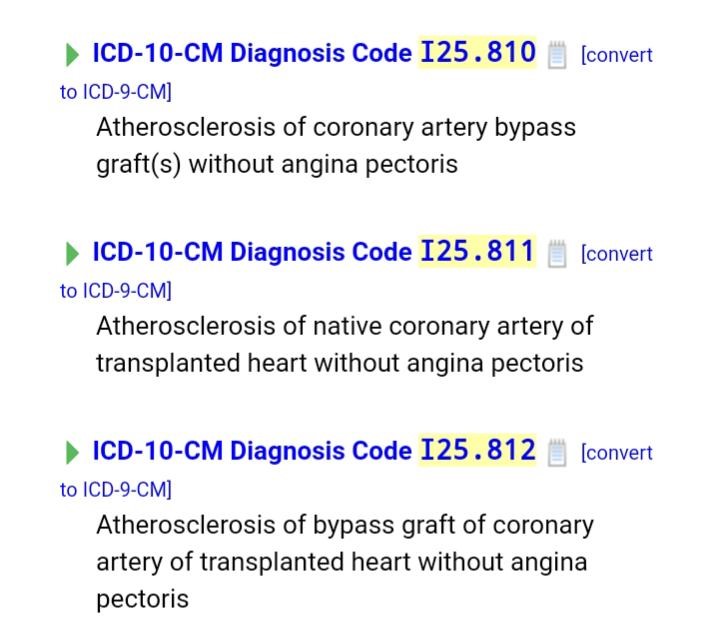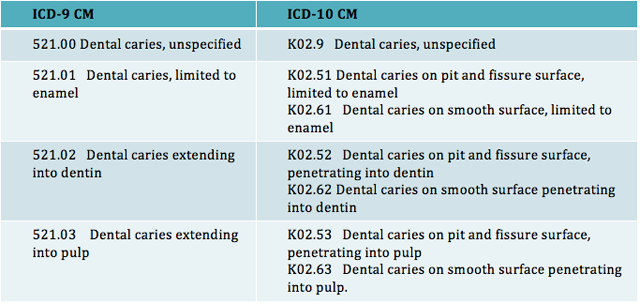

- Icd 10 code cad how to#
- Icd 10 code cad series#


"If the physician just used the term 'CAD' and we know the patient had a CABG procedure in the past without further identification in the documentation, it defaulted to an unspecified vessel," McCall says. McCall, RHIA, CCS, CCS-P, CPC, CPC-I, CEMC, CCDS, director of HIM and coding for HCPro, a division of BLR, in Danvers.
Icd 10 code cad how to#
Bypass graft (artery) (vein) of transplanted heart (414.07)Ĭoding Clinic provided guidance on how to select the correct fifth digit to identify a native artery or a bypass graft in ICD-9-CM, says Shannon E. Native coronary artery of transplanted heart (414.06). Unspecified type of bypass graft (414.05). Nonautologous biological bypass graft (414.03). Autologous biological vein bypass graft (414.02). The codes include choices that describe the affected vessel(s): Icd 10 code cad series#
ICD-9-CM codes for coronary atherosclerosis appear in the 414 series of codes.
» Briefings on Coding Compliance StrategiesĬoding, CDI focus on heart disease differs Briefings on Coding Compliance Strategies, February 1, 2015Ĭoding, CDI focus on heart disease differs. As such, CDI specialists need to look for the acute reason for the admission, that is, the new symptom associated with the chronic CAD, which is often the cause of the inpatient admission. Physicians can usually monitor and treat patients very well in the outpatient setting. The thing that's tricky from a CDI perspective is that CAD is not something that typically needs to be treated in the inpatient setting, Ericson says. In addition, CAD weakens the heart muscles, thereby contributing to heart failure and different arrhythmias. Prolonged oxygen deprivation can lead to tissue death, which is an acute myocardial infarction (AMI). If it's only a brief lack of oxygen, the patient might develop chest pain, more specifically angina, which is a specific type of chest pain associated with CAD. If the heart muscles don't get enough oxygen for long enough, infarction can result, leading to tissue necrosis or death, Ericson says. Usually, but not always, the complications associated with CAD are what lead to death, rather than the chronic condition itself, says Cheryl Ericson, MS, RN, CCDS, CDIP, associate director of education for the Association of Clinical Documentation Improvement (CDI) Specialists in Danvers, Massachusetts.Ītherosclerosis can reduce blood flow, and as a result it can decrease oxygen to the heart muscles. This chronic condition is the leading cause of death in the United States for both men and women. It's also called atherosclerosis.ĬAD is the most common type of heart disease and occurs in a wide range of patients. Some expanded code sets, like ICD-10-CM, have over 70,000 codes.Coronary artery disease (CAD) develops when the arteries that supply the blood to the heart muscles become hardened and narrowed due to a buildup of cholesterol and other materials, such as plaque, on their inner wall. Many more new diagnoses can be tracked using ICD-10 than with ICD-9. ICD-10 is required for use by physicians and healthcare providers under the Health Insurance Portability & Accountability Act (HIPAA) and will replace all ICD-9 code sets. This medical classification list is generated by the World Health Organization (WHO), and is used to help healthcare providers identify and code health conditions. ICD-10 codes are the byproduct of that revision. ICD (International Statistical Classification of Diseases and Related Health problems) is now on its 10th revision. occur with exercise or emotional stress. chest pain or discomfort which may travel into the shoulder, arm, back, neck, or jaw. It is a is a group of diseases that includes: stable angina, unstable angina, myocardial infarction, and sudden coronary death. Its corresponding ICD-9 code is 429.2.Ĭode I25* is the diagnosis code used for Chronic Ischemic Heart Disease, also known as Coronary artery disease (CAD). 
ICD-Code I25* is a non-billable ICD-10 code used for healthcare diagnosis reimbursement of Chronic Ischemic Heart Disease. ICD-10 Code: I25* – Chronic Ischemic Heart Disease








 0 kommentar(er)
0 kommentar(er)
